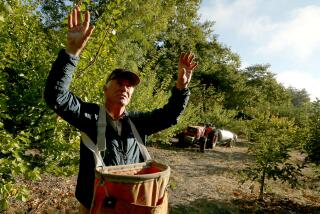Why smaller means sweeter for this summer’s fruit
- Share via
If you think this summer’s fruit seems smaller than you remember, you’re right. And if you think it tastes better, you’re probably right as well. The two things are connected and both are caused by the crazy winter that wasn’t.
Almost across the board, farmers say, peaches, plums, nectarines, apricots and even cherries are much smaller than normal. But smaller does not mean lesser. While that fruit may not be quite as impressive to look at as in the past, the flavor more than makes up for it.
“Fruit this year is running one to 1½ sizes smaller than normal,” says popular farmers market stone fruit grower Fitzgerald Kelly. “But boy, it has been eating really good.”
Partly the smaller size is due to a lack of water brought on by irrigation restrictions caused by the four-year drought. When fruit is deprived of water, it’s naturally smaller — most peaches, for example, are almost 90% water.
“That would tend to make the fruit richer in flavor, up to a certain point,” says David Karp, a principal with Andy Mariani at Xanadu Orchards in Santa Clara County and a longtime farmers market columnist at the Los Angeles Times.
He offers as an example the dry-farmed Royal apricots from Force Field Farm near Santa Paula, which made a brief appearance at the Santa Monica farmers market this spring.
“They looked like hell,” Karp says. “They were tiny and scruffy looking with spots. They were sunburned. But it was like tasting apricot candy or apricot jam. They were rich and complex, the best apricots in the market if you like intensity of flavor.”
But it’s more complicated than just lack of water, says Kevin Day, a pomologist with the University of California’s Cooperative Extension. Day has studied tree fruit for more than 30 years and has been recognized by the National Peach Assn. for his work.
Day says a more important factor was how warm this winter was. That pushed fruit to go through the early stages of its development more rapidly than it normally would, winding up smaller.
Think of fruit growth this way: First, there is the building of the balloon — the creation of all of the cells that will make up the eventual piece of fruit. When that ends, the filling of the balloon begins — with water, sugar and nutrients.
The eventual maximum size of the fruit is set within the first few weeks. After that, even if the trees were given the maximum amount of water, the fruit would still only grow so big.
“The pumps that pump sugar later in the season run at the same rate no matter how big the fruit is,” Day says. But this year “instead of filling a big reservoir, they’re filling a smaller reservoir, so naturally the fruit tastes sweeter.”
Because of the exceedingly warm winter, he says, most fruits were “just destined to be runts this year, and as a consequence, they’re destined to have a higher sugar potential.”
It’s not like farmers didn’t see this coming. In fact, famed Fresno peach farmer David Mas Masumoto and his artist-farmer daughter Nikiko devised a marketing trial around it, calling these fruits “Petite Peaches” and glorifying the whole “smaller is better” aesthetic.
This summer they deprived certain portions of each orchard of water, giving them just enough to keep the trees alive, and knowing that the resulting fruit would be even smaller. They say they were able to reduce water use by 25% without harming flavor. In fact, Nikiko Masumoto says, “in all of the varieties, the fruit either tasted just as great or, in a couple of varieties, we thought the small fruit actually tasted better.”
The experiment was not a total success, though. It seems shoppers’ brains might be hard-wired to prefer big fruit, and even at stores with knowledgeable and supportive buyers, sales of these small fruits were slow.
At wholesale, the small sizes fetched prices that were only half what their bigger counterparts earned — less than what it cost to grow and harvest them. Even at the Bay Area’s famed Berkeley Bowl — Ground Zero of sustainable gourmandism — shoppers turned up their noses.
Masumoto says “I think there’s just an unconscious implicit bias that over and over we’ve been told that certain size fruit is better, even though we know that smaller ones have the best flavor.”
Are you a food geek? Follow me on Twitter @russ_parsons1
More to Read
Eat your way across L.A.
Get our weekly Tasting Notes newsletter for reviews, news and more.
You may occasionally receive promotional content from the Los Angeles Times.







